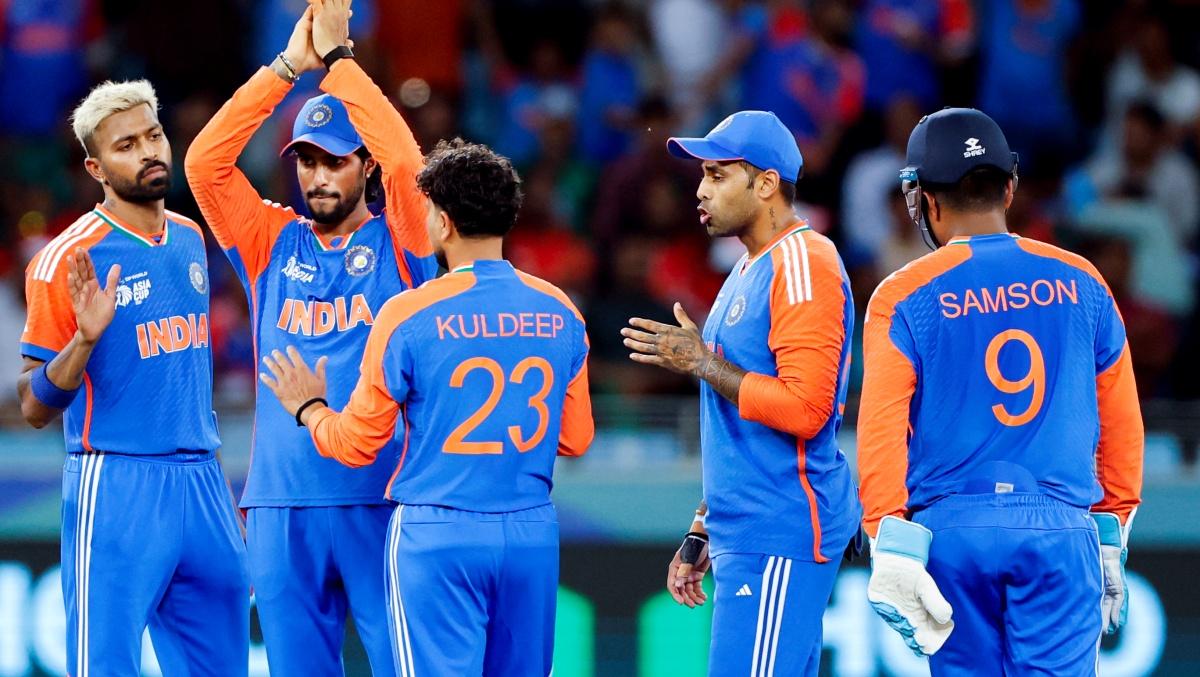


IMAGE: Team India aims for consistency and dominance. Photograph: ANI Photo
India will face Sri Lanka at the Dubai international cricket stadium on Friday, September 26, in a largely inconsequential Super Fours clash.
With India already booked into the Asia Cup 2025 final after a commanding 41 run win over Bangladesh, and Sri Lanka eliminated following defeats to both Bangladesh and Pakistan, the outcome of this sixth match will have little impact on the tournament standings.
For India, this fixture presents a crucial opportunity to address several concerning issues that have emerged during their otherwise successful campaign, particularly ahead of the final where they await the winner of Thursday's Bangladesh-Pakistan clash.
Abhishek Shines, But India's Middle Order Falters
IMAGE: Abhishek Sharma has been magnificent. Photograph: BCCI/X
India's batting has so far been dominated by ICC T20I No. 1 batter Abhishek Sharma. The explosive opener has been in sensational form, following up his magnificent 39 ball 74 against Pakistan with an equally impressive 37 ball 75 against Bangladesh.
His performances have single-handedly carried India through challenging phases, but this over-reliance has exposed a glaring weakness in the middle order.
The pattern has become worryingly predictable: When Abhishek is at the crease, India look unstoppable, capable of posting imposing totals.
However, once he departs, the batting order crumbles like a house of cards. Against Bangladesh, India appeared destined for 200 and beyond when Abhishek was in full flow, but they struggled significantly after his dismissal, eventually managing only 168.
IMAGE: Hardik Pandya is struggling to deliver consistent middle order runs. Photograph: BCCI/X
Tilak Varma, Suryakumar Yadav and Hardik Pandya have failed to provide consistent contributions, leaving India vulnerable against stronger opposition.
The team management's batting order experiments, including promoting Shivam Dube to No. 3 in the Bangladesh game and shuffling the middle order, haven't yielded the desired results, with Sanju Samson not even getting a chance to bat in the last match.
This over-dependence on one player is a recipe for disaster in knockout cricket, and India's think-tank will be acutely aware that a repetition of these middle order failures in the final could prove catastrophic.
Fielding Woes Under Dubai Lights
IMAGE: India's fielding under pressure as catches continue to be dropped. Photograph: ANI Photo
Perhaps more concerning than the batting issues is India's fielding performance, which has been nothing short of abysmal.
The team has dropped a staggering 12 catches throughout the tournament, boasting an efficiency rate of just 67.5 per cent -- the second-lowest among all participating nations.
Indian fielders struggle under the Dubai lights, repeatedly misjudging catches beneath the stadium's 'rings of fire'.
Against Bangladesh, Saif Hassan was handed four unprecedented lifelines, being dropped on scores of 40, 65, 66 and 67 before finally being dismissed for 69. This pattern had been evident in their previous match against Pakistan as well, where four dropped catches and several fielding errors nearly cost them the game.
Varun Chakravarthy, who has been impressive with the ball, taking four wickets in four games at an excellent economy rate of 5.85, has been particularly unlucky with catches being dropped off his bowling. These missed opportunities could prove decisive in a high-stakes final.
Bowling Department Shows Promise
IMAGE: Kuldeep Yadav spins his way into Asia Cup history. Photograph: BCCI/X
The bowling unit has been India's strongest department, with several bowlers making significant contributions.
Kuldeep Yadav has been exceptional, recently entering the history books as India's highest wicket-taker in Asia Cup history (ODIs and T20Is combined) with 31 wickets overall.
His figures of 3 for 18 against Bangladesh, taking his tournament tally to 12 wickets in five matches, demonstrate his current purple patch.
Jasprit Bumrah's workload management has been a talking point. Despite taking only five wickets in four games, the team management remains satisfied with his performances, considering the 'exceptionally tough job' he's been assigned.
Bowling three overs in the Powerplay and his fourth at the death in every match represents a significant workload.
Given the dead rubber nature of Friday's encounter, India might consider resting key players, particularly Bumrah, whose workload has been intense.
Assistant Coach Ryan ten Doeschate has acknowledged the strenuous nature of Bumrah's role, and with the final looming and a Test series against the West Indies following, managing his fitness becomes crucial.
The Dubai pitch is expected to remain batter-friendly, particularly favouring teams chasing, which could provide ideal conditions for India to test their middle order's mettle.
To defend their Asia Cup title, India must improve catching and find a steady middle order. Friday's dead rubber is a good chance to try these out.
Who do you think should be part of the Indian team for the Super Fours match against Sri Lanka?
Please select your team from the list below and do post your playing XI in the message board below:
Asia Cup 2025
Your email address will not be published. Required fields are marked *
No comments yet. Be the first to comment!